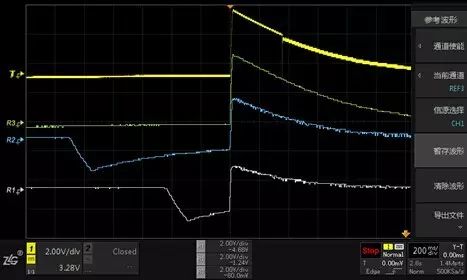The ZDS2022 oscilloscope’s hundred technical exchange meetings are still in full swing. Through communication with a certain customer, it was learned that one of their samples may have abnormal waveforms at the moment of power-up. Today, we will use the ZDS2022 to capture the power-on signal multiple times and observe the real-time comparison of multiple sets of power-on waveforms on the same screen! How do we achieve this?
In the multifunctional control area of the front panel of the ZDS2022 oscilloscope, there is a reference waveform button [Ref]. The reference waveform function can temporarily store the measured waveform on the screen and supports three reference channels for waveform storage. Press “Channel Enable”, rotate knob A to REF1, and briefly press knob A to select REF1. Choosing “Store Waveform” will temporarily store the currently captured power-on waveform, which will appear as the white reference waveform 1 on the main interface. Similarly, by selecting REF2 in the channel enable, powering the sample for the second time, and choosing to store the waveform, a light blue reference waveform 2 will appear on the main interface. Selecting REF3 in the channel enable, powering the sample for the third time, and choosing to store the waveform will result in a light yellow reference waveform 3 appearing on the main interface. After powering the sample for the fourth time, the current screen will display four sets of power-on waveforms.

Figure 1: Four Sets of Power-On Waveforms Displayed on One Screen
This comparative observation chart is very valuable, as it clearly shows the comparison of the four sets of power-on waveforms, and the specific locations of anomalies are also very clear!
The design of the reference waveform function in the ZDS2022 helps users quickly analyze and determine the cause of faults, making it very practical!
